Page 702 of 1456
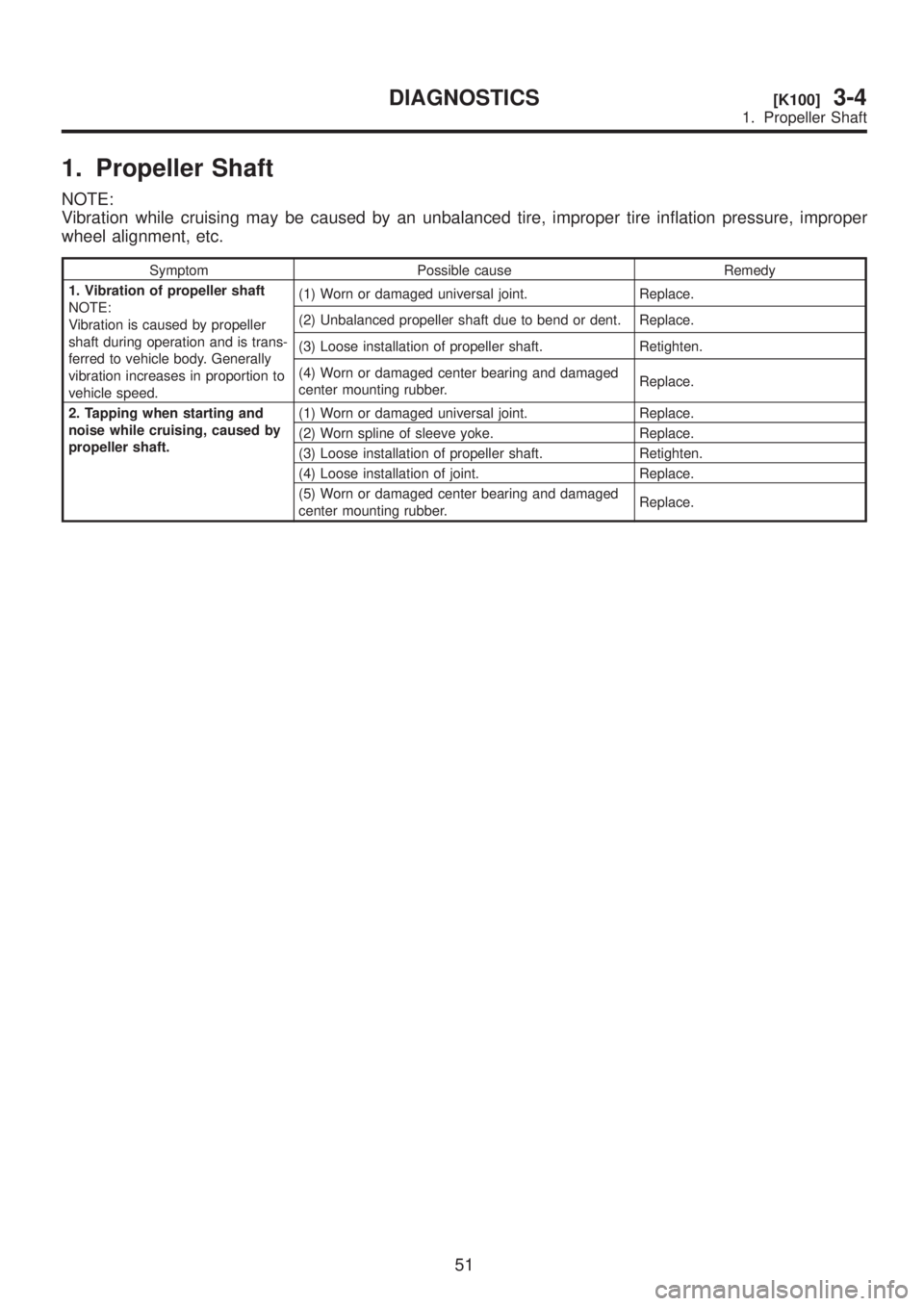
1. Propeller Shaft
NOTE:
Vibration while cruising may be caused by an unbalanced tire, improper tire inflation pressure, improper
wheel alignment, etc.
Symptom Possible cause Remedy
1. Vibration of propeller shaft
NOTE:
Vibration is caused by propeller
shaft during operation and is trans-
ferred to vehicle body. Generally
vibration increases in proportion to
vehicle speed.(1) Worn or damaged universal joint. Replace.
(2) Unbalanced propeller shaft due to bend or dent. Replace.
(3) Loose installation of propeller shaft. Retighten.
(4) Worn or damaged center bearing and damaged
center mounting rubber.Replace.
2. Tapping when starting and
noise while cruising, caused by
propeller shaft.(1) Worn or damaged universal joint. Replace.
(2) Worn spline of sleeve yoke. Replace.
(3) Loose installation of propeller shaft. Retighten.
(4) Loose installation of joint. Replace.
(5) Worn or damaged center bearing and damaged
center mounting rubber.Replace.
51
[K100]3-4DIAGNOSTICS
1. Propeller Shaft
Page 705 of 1456
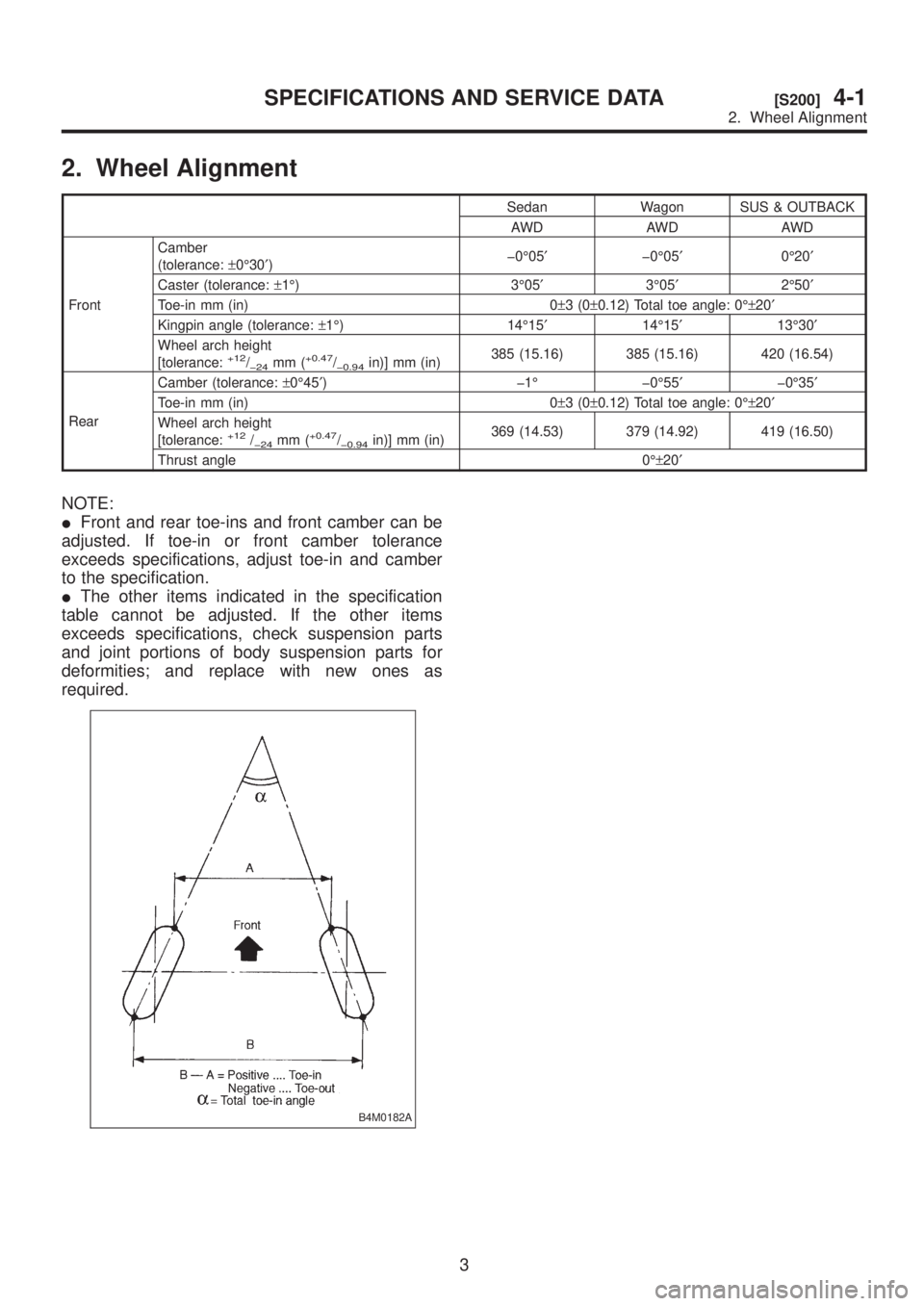
2. Wheel Alignment
Sedan Wagon SUS & OUTBACK
AWD AWD AWD
FrontCamber
(tolerance:±0É30¢)þ0É05¢þ0É05¢0É20¢
Caster (tolerance:±1É) 3É05¢3É05¢2É50¢
Toe-in mm (in) 0±3(0±0.12) Total toe angle: 0ɱ20¢
Kingpin angle (tolerance:±1É) 14É15¢14É15¢13É30¢
Wheel arch height
[tolerance:
+12/þ24mm (+0.47/þ0.94in)] mm (in)385 (15.16) 385 (15.16) 420 (16.54)
RearCamber (tolerance:±0É45¢) þ1É þ0É55¢þ0É35¢
Toe-in mm (in) 0±3(0±0.12) Total toe angle: 0ɱ20¢
Wheel arch height
[tolerance:
+12/þ24mm (+0.47/þ0.94in)] mm (in)369 (14.53) 379 (14.92) 419 (16.50)
Thrust angle 0ɱ20¢
NOTE:
IFront and rear toe-ins and front camber can be
adjusted. If toe-in or front camber tolerance
exceeds specifications, adjust toe-in and camber
to the specification.
IThe other items indicated in the specification
table cannot be adjusted. If the other items
exceeds specifications, check suspension parts
and joint portions of body suspension parts for
deformities; and replace with new ones as
required.
B4M0182A
3
[S200]4-1SPECIFICATIONS AND SERVICE DATA
2. Wheel Alignment
Page 709 of 1456
1. On-car Services
A: WHEEL ALIGNMENT
PROCEDURES
Check, adjust and/or measure wheel alignment in
accordance with procedures indicated in figure:
B4M1088A
7
[W1A0]4-1SERVICE PROCEDURE
1. On-car Services
Page 711 of 1456
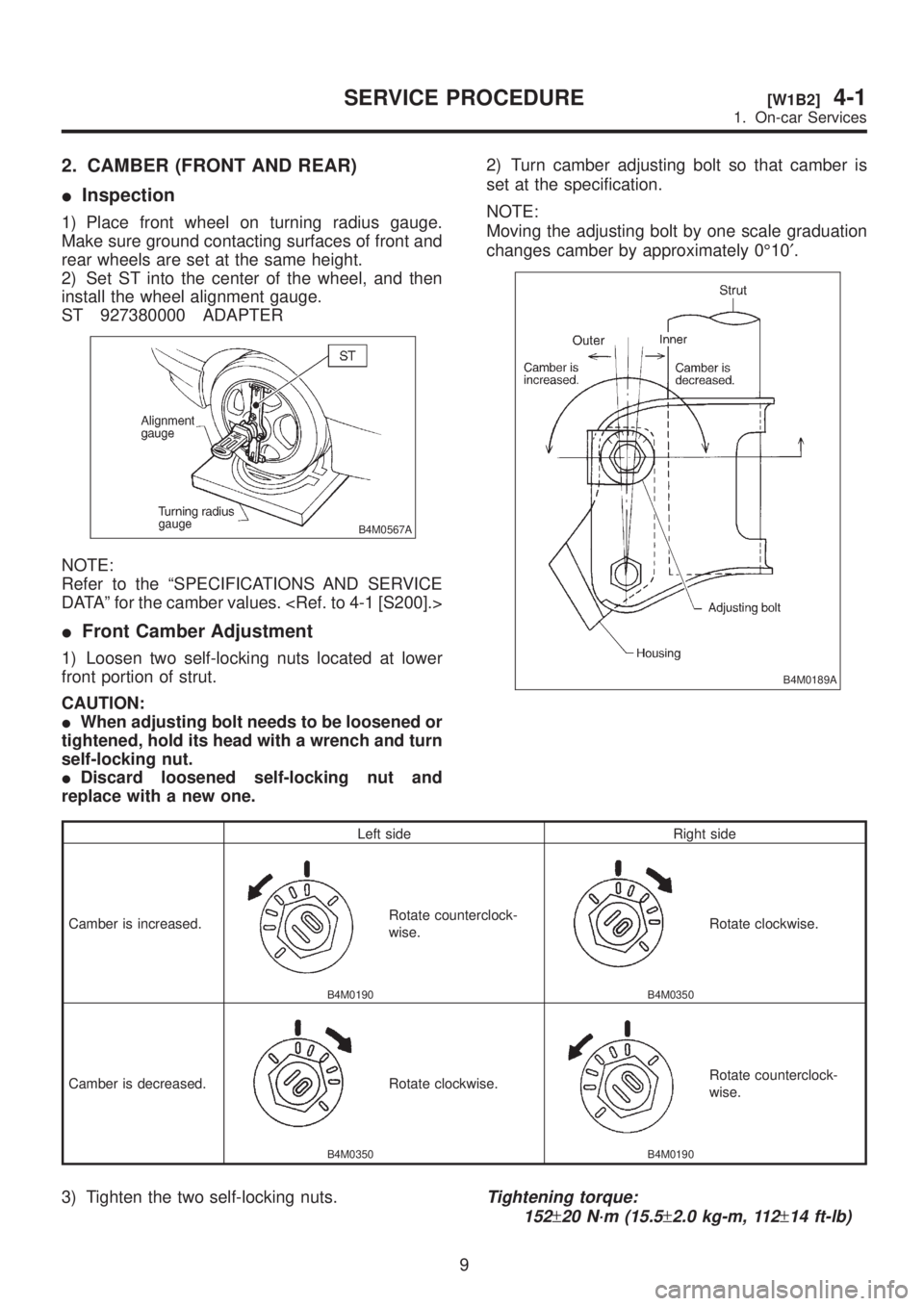
2. CAMBER (FRONT AND REAR)
IInspection
1) Place front wheel on turning radius gauge.
Make sure ground contacting surfaces of front and
rear wheels are set at the same height.
2) Set ST into the center of the wheel, and then
install the wheel alignment gauge.
ST 927380000 ADAPTER
B4M0567A
NOTE:
Refer to the ªSPECIFICATIONS AND SERVICE
DATAº for the camber values.
IFront Camber Adjustment
1) Loosen two self-locking nuts located at lower
front portion of strut.
CAUTION:
IWhen adjusting bolt needs to be loosened or
tightened, hold its head with a wrench and turn
self-locking nut.
IDiscard loosened self-locking nut and
replace with a new one.2) Turn camber adjusting bolt so that camber is
set at the specification.
NOTE:
Moving the adjusting bolt by one scale graduation
changes camber by approximately 0É10¢.
B4M0189A
Left side Right side
Camber is increased.
B4M0190
Rotate counterclock-
wise.
B4M0350
Rotate clockwise.
Camber is decreased.
B4M0350
Rotate clockwise.
B4M0190
Rotate counterclock-
wise.
3) Tighten the two self-locking nuts.Tightening torque:
152
±20 N´m (15.5±2.0 kg-m, 112±14 ft-lb)
9
[W1B2]4-1SERVICE PROCEDURE
1. On-car Services
Page 712 of 1456
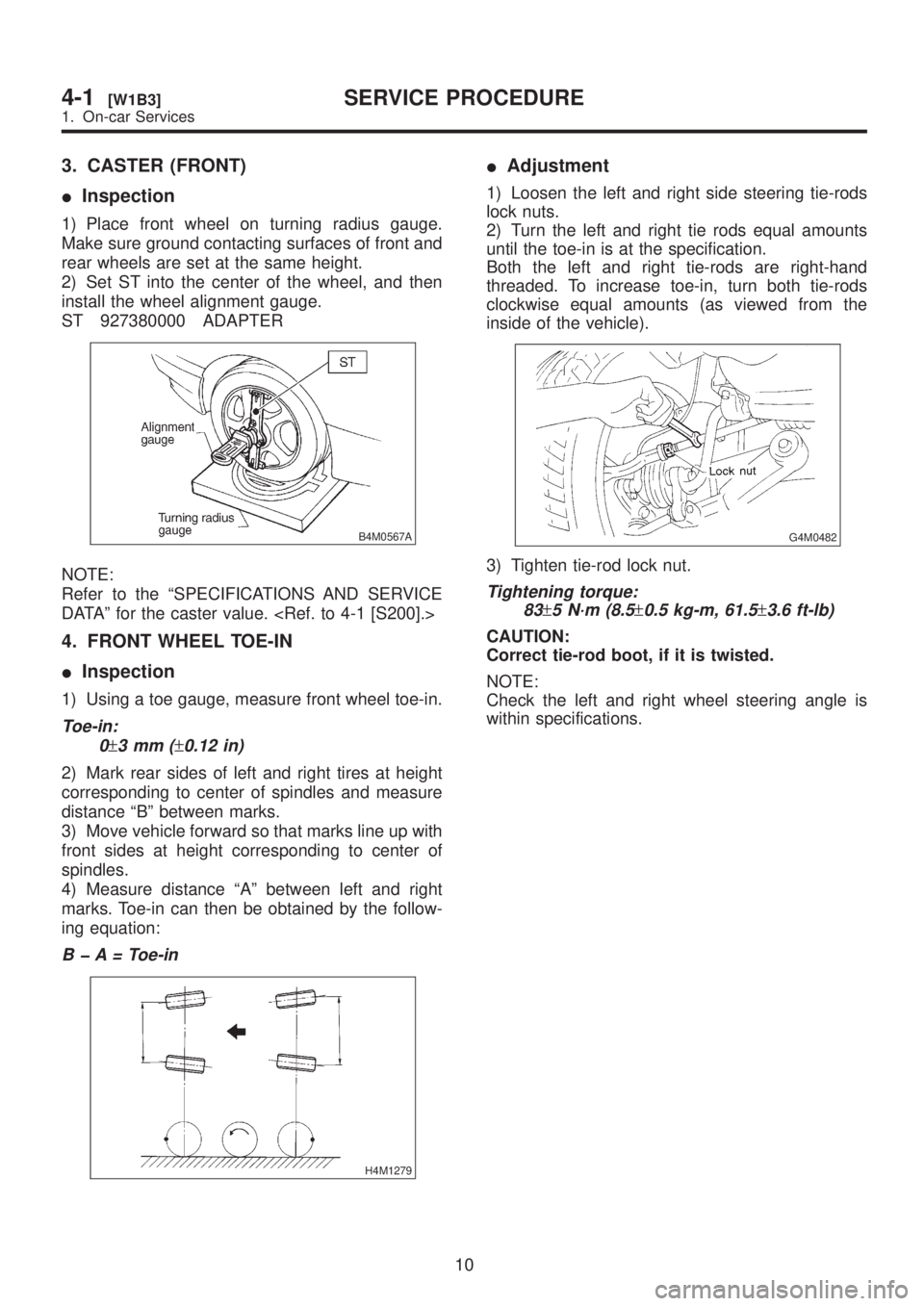
3. CASTER (FRONT)
IInspection
1) Place front wheel on turning radius gauge.
Make sure ground contacting surfaces of front and
rear wheels are set at the same height.
2) Set ST into the center of the wheel, and then
install the wheel alignment gauge.
ST 927380000 ADAPTER
B4M0567A
NOTE:
Refer to the ªSPECIFICATIONS AND SERVICE
DATAº for the caster value.
4. FRONT WHEEL TOE-IN
IInspection
1) Using a toe gauge, measure front wheel toe-in.
Toe-in:
0
±3mm(±0.12 in)
2) Mark rear sides of left and right tires at height
corresponding to center of spindles and measure
distance ªBº between marks.
3) Move vehicle forward so that marks line up with
front sides at height corresponding to center of
spindles.
4) Measure distance ªAº between left and right
marks. Toe-in can then be obtained by the follow-
ing equation:
B þ A = Toe-in
H4M1279
IAdjustment
1) Loosen the left and right side steering tie-rods
lock nuts.
2) Turn the left and right tie rods equal amounts
until the toe-in is at the specification.
Both the left and right tie-rods are right-hand
threaded. To increase toe-in, turn both tie-rods
clockwise equal amounts (as viewed from the
inside of the vehicle).
G4M0482
3) Tighten tie-rod lock nut.
Tightening torque:
83
±5 N´m (8.5±0.5 kg-m, 61.5±3.6 ft-lb)
CAUTION:
Correct tie-rod boot, if it is twisted.
NOTE:
Check the left and right wheel steering angle is
within specifications.
10
4-1[W1B3]SERVICE PROCEDURE
1. On-car Services
Page 718 of 1456
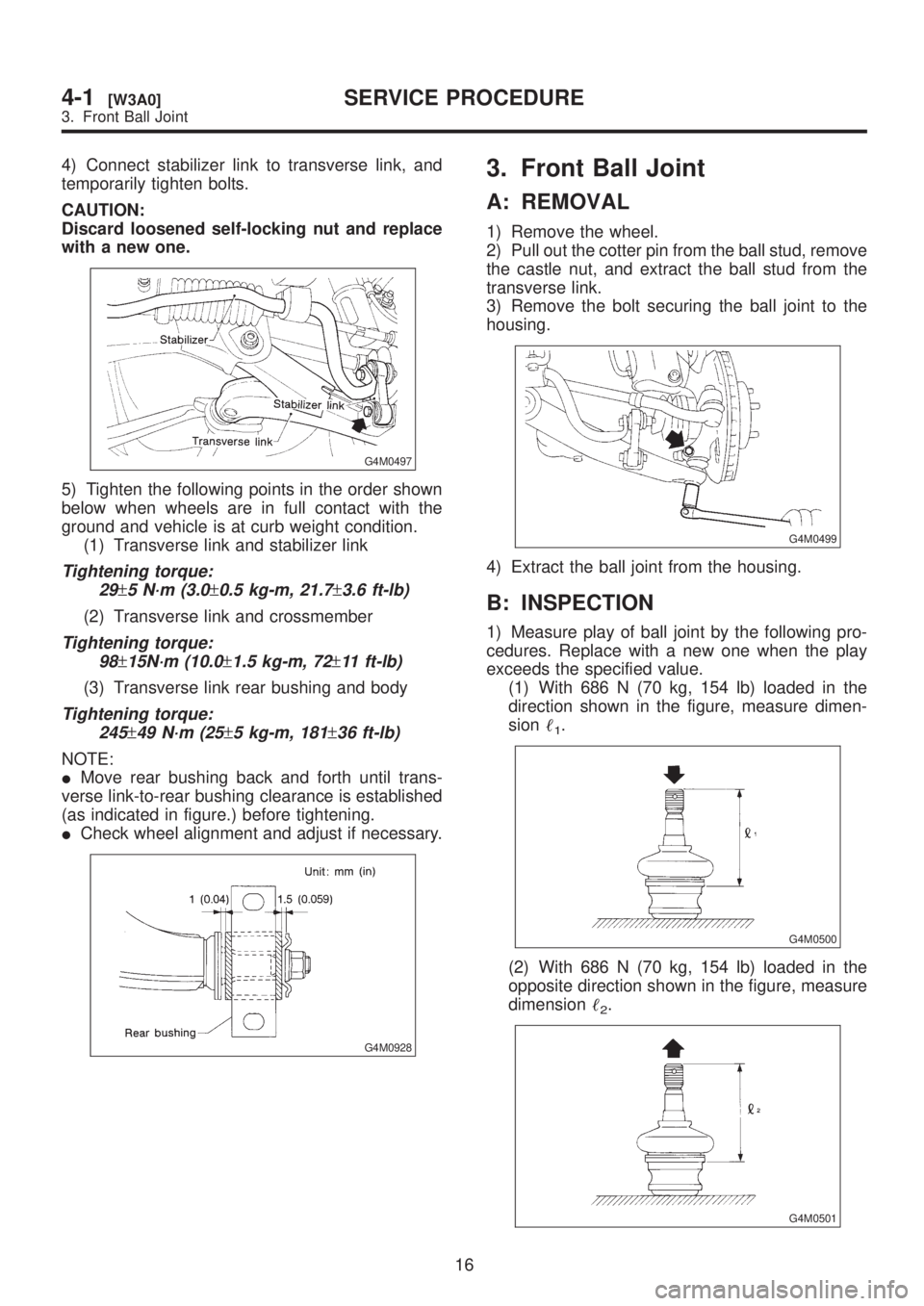
4) Connect stabilizer link to transverse link, and
temporarily tighten bolts.
CAUTION:
Discard loosened self-locking nut and replace
with a new one.
G4M0497
5) Tighten the following points in the order shown
below when wheels are in full contact with the
ground and vehicle is at curb weight condition.
(1) Transverse link and stabilizer link
Tightening torque:
29
±5 N´m (3.0±0.5 kg-m, 21.7±3.6 ft-lb)
(2) Transverse link and crossmember
Tightening torque:
98
±15N´m (10.0±1.5 kg-m, 72±11 ft-lb)
(3) Transverse link rear bushing and body
Tightening torque:
245
±49 N´m (25±5 kg-m, 181±36 ft-lb)
NOTE:
IMove rear bushing back and forth until trans-
verse link-to-rear bushing clearance is established
(as indicated in figure.) before tightening.
ICheck wheel alignment and adjust if necessary.
G4M0928
3. Front Ball Joint
A: REMOVAL
1) Remove the wheel.
2) Pull out the cotter pin from the ball stud, remove
the castle nut, and extract the ball stud from the
transverse link.
3) Remove the bolt securing the ball joint to the
housing.
G4M0499
4) Extract the ball joint from the housing.
B: INSPECTION
1) Measure play of ball joint by the following pro-
cedures. Replace with a new one when the play
exceeds the specified value.
(1) With 686 N (70 kg, 154 lb) loaded in the
direction shown in the figure, measure dimen-
sion
1.
G4M0500
(2) With 686 N (70 kg, 154 lb) loaded in the
opposite direction shown in the figure, measure
dimension
2.
G4M0501
16
4-1[W3A0]SERVICE PROCEDURE
3. Front Ball Joint
Page 719 of 1456
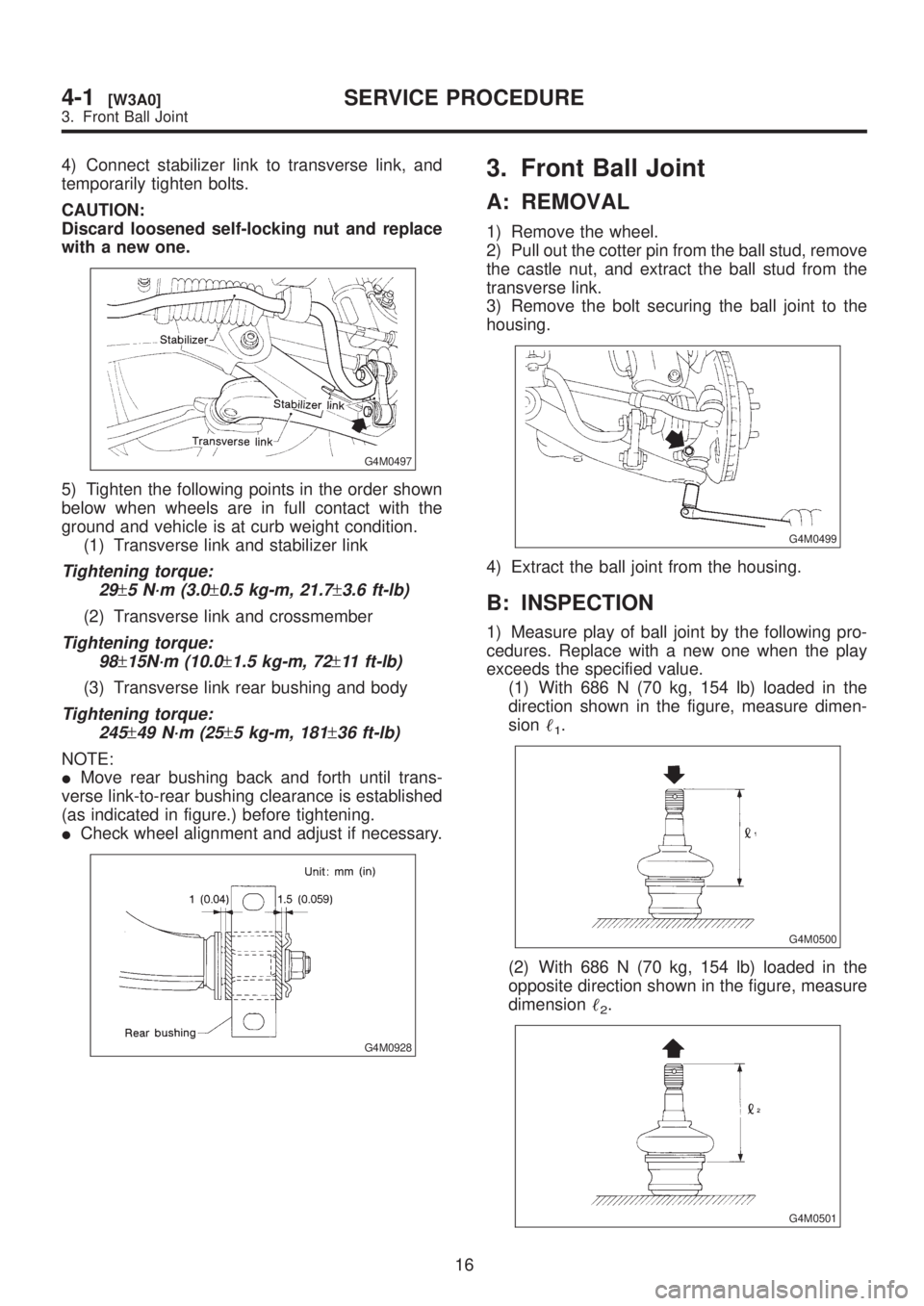
4) Connect stabilizer link to transverse link, and
temporarily tighten bolts.
CAUTION:
Discard loosened self-locking nut and replace
with a new one.
G4M0497
5) Tighten the following points in the order shown
below when wheels are in full contact with the
ground and vehicle is at curb weight condition.
(1) Transverse link and stabilizer link
Tightening torque:
29
±5 N´m (3.0±0.5 kg-m, 21.7±3.6 ft-lb)
(2) Transverse link and crossmember
Tightening torque:
98
±15N´m (10.0±1.5 kg-m, 72±11 ft-lb)
(3) Transverse link rear bushing and body
Tightening torque:
245
±49 N´m (25±5 kg-m, 181±36 ft-lb)
NOTE:
IMove rear bushing back and forth until trans-
verse link-to-rear bushing clearance is established
(as indicated in figure.) before tightening.
ICheck wheel alignment and adjust if necessary.
G4M0928
3. Front Ball Joint
A: REMOVAL
1) Remove the wheel.
2) Pull out the cotter pin from the ball stud, remove
the castle nut, and extract the ball stud from the
transverse link.
3) Remove the bolt securing the ball joint to the
housing.
G4M0499
4) Extract the ball joint from the housing.
B: INSPECTION
1) Measure play of ball joint by the following pro-
cedures. Replace with a new one when the play
exceeds the specified value.
(1) With 686 N (70 kg, 154 lb) loaded in the
direction shown in the figure, measure dimen-
sion
1.
G4M0500
(2) With 686 N (70 kg, 154 lb) loaded in the
opposite direction shown in the figure, measure
dimension
2.
G4M0501
16
4-1[W3A0]SERVICE PROCEDURE
3. Front Ball Joint
Page 721 of 1456
4. Front Strut
A: REMOVAL
B4M1085A
(1) Dust seal
(2) Strut mount
(3) Spacer
(4) Upper spring seat
(5) Rubber seat
(6) Dust cover(7) Helper
(8) Coil spring
(9) Damper strut
(10) Adjusting bolt
(11) Self-locking nutTightening torque: N´m (kg-m, ft-lb)
T1:
20±6 (2.0±0.6, 14.5±4.3)
T2:54±5 (5.5±0.5, 39.8±3.6)
T3:152±20 (15.5±2.0, 112±14)
1) Remove wheel.
2) Depress brake pedal and hold it down using a
wooden block etc.
3) Remove union bolts from caliper.
CAUTION:
Use brake hose cap to prevent brake fluid from
escaping.
G4M0503
4) Remove brake hose clamp and disconnect
brake hose from strut. Attach brake hose to body
using gum tape.
G4M0504
5) Scribe an alignment mark on the camber
adjusting bolt which secures strut to housing.
6) Remove bolt securing the ABS sensor harness.
(ABS equipped models.)
18
4-1[W4A0]SERVICE PROCEDURE
4. Front Strut